Samer Hanna
Distributed Transmit Beamforming: Analyzing the Maximum Communication Range
May 10, 2022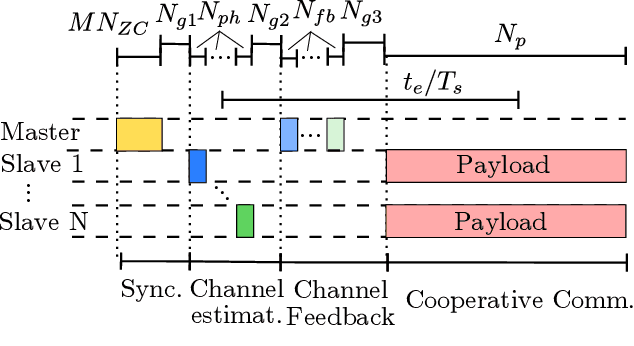

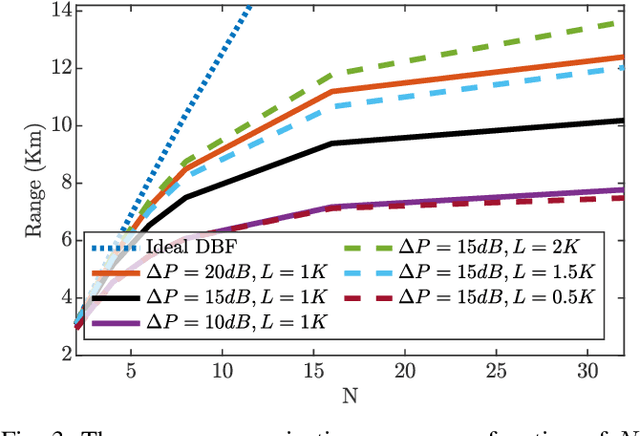
Abstract:Distributed transmit beamforming is a technique that adjusts the signals from cooperating radios to combine coherently at a destination radio. To achieve coherent combining, the radios can exchange preambles with the destination for frequency synchronization and signal phase adjustment. At the destination, coherent combining leads to a beamforming (BF) gain. The BF gain can extend the communication range by countering the path loss that increases with the distance from the destination. While ideally the maximum range can be trivially calculated from the BF gain, in reality, the BF gain depends on the distance because, at a larger distance, lower SNR of the exchanged preambles causes higher synchronization and phase estimation errors, which in turn degrades the BF gain. In this paper, considering the BF gain degradation for a destination-led BF protocol, we calculate the maximum communication range to realize a desired post-BF SNR by analyzing the relation between the pre-BF SNR and the BF gain. We show that increasing the preamble lengths or increasing the destination power can significantly increase the maximum range while just increasing the number of radios gives diminishing range extension.
WiSig: A Large-Scale WiFi Signal Dataset for Receiver and Channel Agnostic RF Fingerprinting
Jan 12, 2022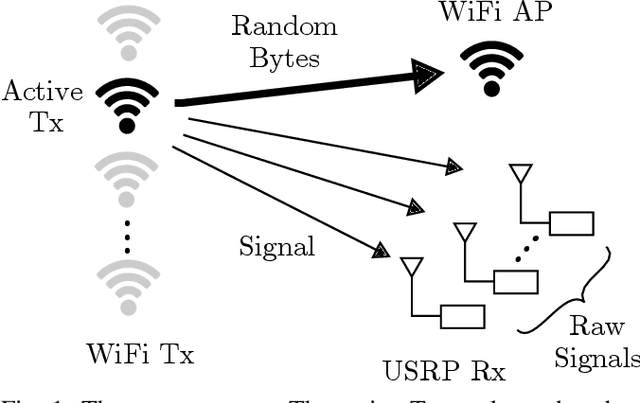
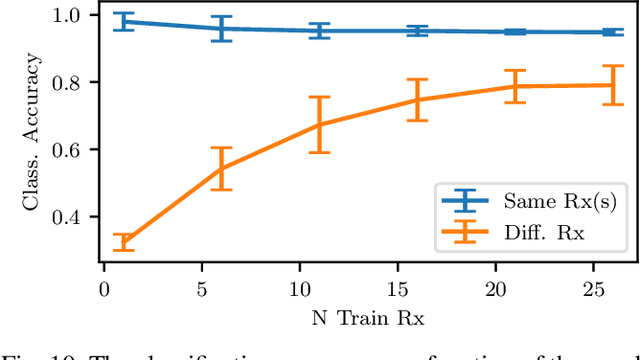
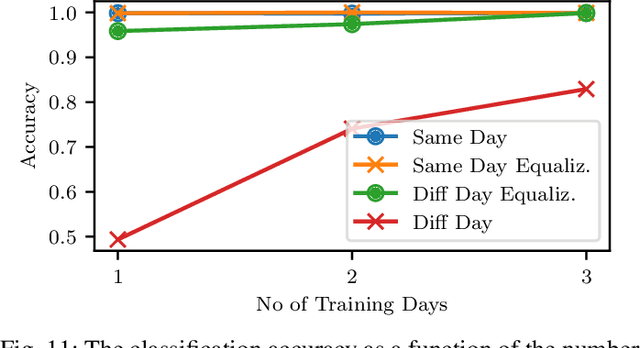
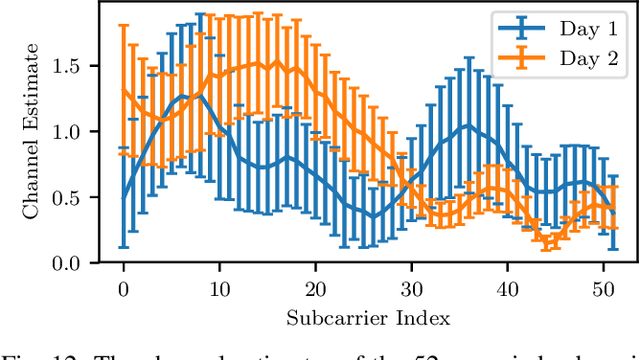
Abstract:RF fingerprinting leverages circuit-level variability of transmitters to identify them using signals they send. Signals used for identification are impacted by a wireless channel and receiver circuitry, creating additional impairments that can confuse transmitter identification. Eliminating these impairments or just evaluating them, requires data captured over a prolonged period of time, using many spatially separated transmitters and receivers. In this paper, we present WiSig; a large scale WiFi dataset containing 10 million packets captured from 174 off-the-shelf WiFi transmitters and 41 USRP receivers over 4 captures spanning a month. WiSig is publicly available, not just as raw captures, but as conveniently pre-processed subsets of limited size, along with the scripts and examples. A preliminary evaluation performed using WiSig shows that changing receivers, or using signals captured on a different day can significantly degrade a trained classifier's performance. While capturing data over more days or more receivers limits the degradation, it is not always feasible and novel data-driven approaches are needed. WiSig provides the data to develop and evaluate these approaches towards channel and receiver agnostic transmitter fingerprinting.
Real-time Wireless Transmitter Authorization: Adapting to Dynamic Authorized Sets with Information Retrieval
Nov 04, 2021

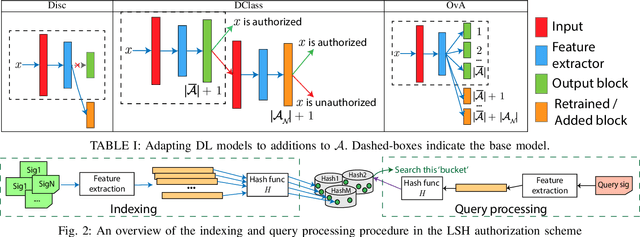
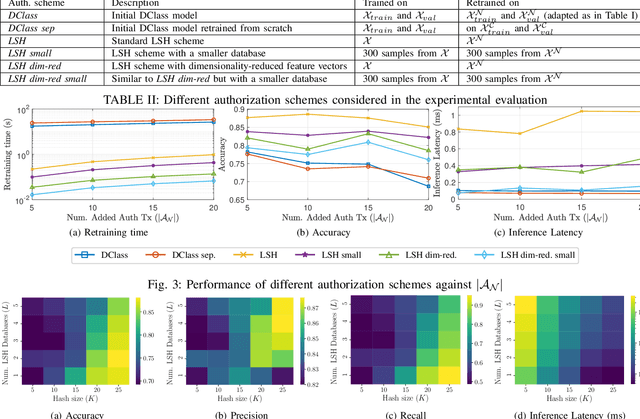
Abstract:As the Internet of Things (IoT) continues to grow, ensuring the security of systems that rely on wireless IoT devices has become critically important. Deep learning-based passive physical layer transmitter authorization systems have been introduced recently for this purpose, as they accommodate the limited computational and power budget of such devices. These systems have been shown to offer excellent outlier detection accuracies when trained and tested on a fixed authorized transmitter set. However in a real-life deployment, a need may arise for transmitters to be added and removed as the authorized set of transmitters changes. In such cases, the system could experience long down-times, as retraining the underlying deep learning model is often a time-consuming process. In this paper, we draw inspiration from information retrieval to address this problem: by utilizing feature vectors as RF fingerprints, we first demonstrate that training could be simplified to indexing those feature vectors into a database using locality sensitive hashing (LSH). Then we show that approximate nearest neighbor search could be performed on the database to perform transmitter authorization that matches the accuracy of deep learning models, while allowing for more than 100x faster retraining. Furthermore, dimensionality reduction techniques are used on the feature vectors to show that the authorization latency of our technique could be reduced to approach that of traditional deep learning-based systems.
Distributed Transmit Beamforming: Design and Demonstration from the Lab to UAVs
Oct 26, 2021



Abstract:Cooperating radios can extend their communication range by adjusting their signals to ensure coherent combining at a destination radio. This technique is called distributed transmit beamforming. Beamforming (BF) relies on the BF radios having frequency synchronized carriers and phases adjusted for coherent combining. Both requirements are typically met by exchanging preambles with the destination. However, since BF aims to increase the communication range, the individually transmitted preambles are typically at low SNR and their lengths are constrained by the channel coherence time. These noisy preambles lead to errors in frequency and phase estimation, which result in randomly changing BF gains. To build reliable distributed BF systems, the impact of estimation errors on the BF gains need to be considered in the design. In this work, assuming a destination-led BF protocol and Kalman filter for frequency tracking, we optimize the number of BF radios and the preamble lengths to achieve reliable BF gain. To do that, we characterize the relations between the BF gains distribution, the channel coherence time, and design parameters like the SNR, preamble lengths, and the number of radios. The proposed relations are verified using simulations and via experiments using software-defined radios in a lab and on UAVs.
Open Set RF Fingerprinting using Generative Outlier Augmentation
Aug 30, 2021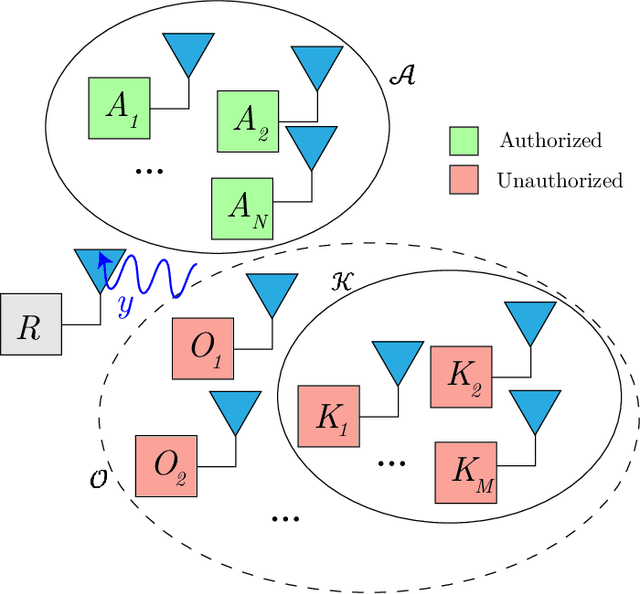
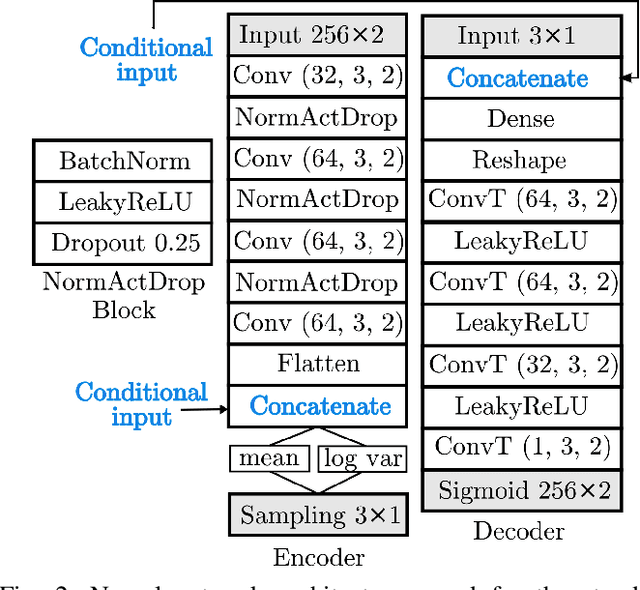
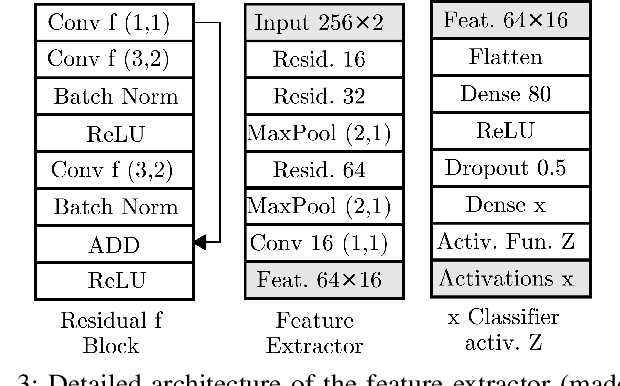
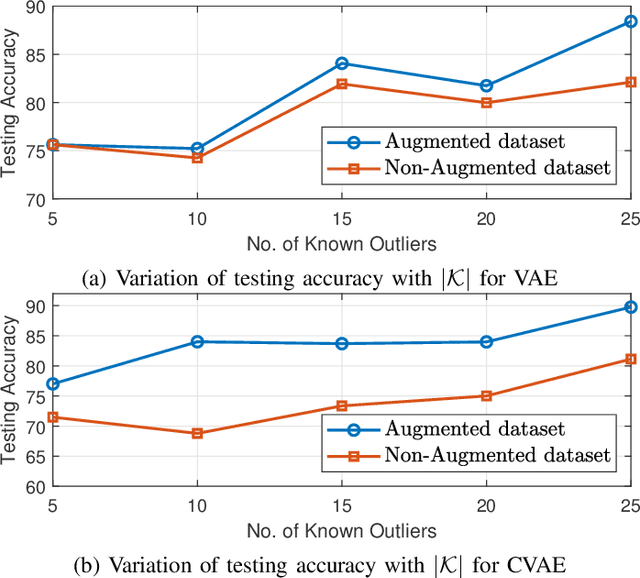
Abstract:RF devices can be identified by unique imperfections embedded in the signals they transmit called RF fingerprints. The closed set classification of such devices, where the identification must be made among an authorized set of transmitters, has been well explored. However, the much more difficult problem of open set classification, where the classifier needs to reject unauthorized transmitters while recognizing authorized transmitters, has only been recently visited. So far, efforts at open set classification have largely relied on the utilization of signal samples captured from a known set of unauthorized transmitters to aid the classifier learn unauthorized transmitter fingerprints. Since acquiring new transmitters to use as known transmitters is highly expensive, we propose to use generative deep learning methods to emulate unauthorized signal samples for the augmentation of training datasets. We develop two different data augmentation techniques, one that exploits a limited number of known unauthorized transmitters and the other that does not require any unauthorized transmitters. Experiments conducted on a dataset captured from a WiFi testbed indicate that data augmentation allows for significant increases in open set classification accuracy, especially when the authorized set is small.
Feedback Free Distributed Transmit Beamforming using Guided Directionality
Aug 04, 2021



Abstract:Distributed transmit beamforming enables cooperative radios to act as one virtual antenna array, extending their communications' range beyond the capabilities of a single radio. Most existing distributed beamforming approaches rely on the destination radio sending feedback to adjust the transmitters' signals for coherent combining. However, relying on the destination radio's feedback limits the communications range to that of a single radio. Existing feedback free approaches rely on phase synchronization and knowing the node locations with sub-wavelength accuracy, which becomes impractical for radios mounted on high-mobility platforms like UAVs. In this work, we propose and demonstrate a feedback free distributed beamforming approach that leverages the radio's mobility and coarse location information in a dominant line-of-sight channel. In the proposed approach, one radio acts as a guide and moves to point the beam of the remaining radios towards the destination. We specify the radios' position requirements and verify their relation to the combined signal at the destination using simulations. A proof of concept demo was implemented using software defined radios, showing up to 9dB SNR improvement in the beamforming direction just by relying on the coarse placement of four radios.
Signal Processing Based Deep Learning for Blind Symbol Decoding and Modulation Classification
Jun 19, 2021
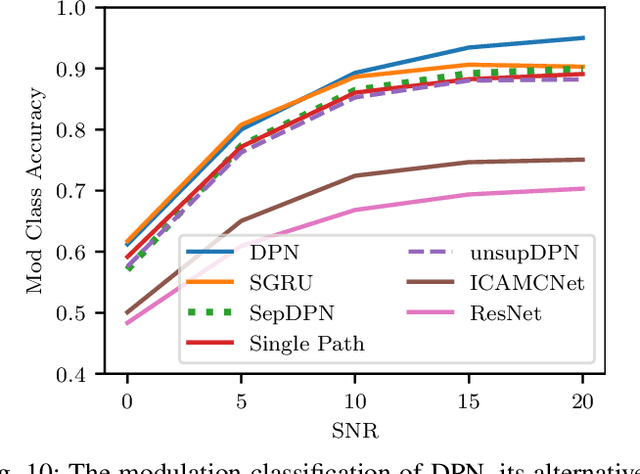
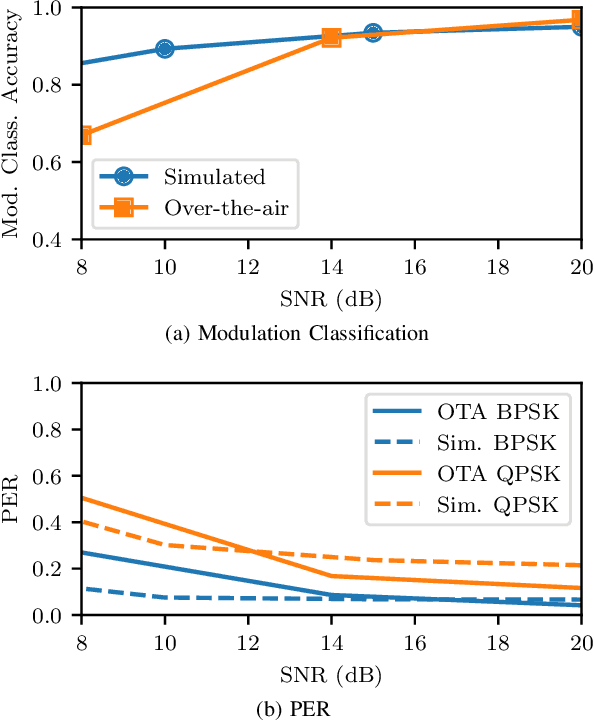

Abstract:Blindly decoding a signal requires estimating its unknown transmit parameters, compensating for the wireless channel impairments, and identifying the modulation type. While deep learning can solve complex problems, digital signal processing (DSP) is interpretable and can be more computationally efficient. To combine both, we propose the dual path network (DPN). It consists of a signal path of DSP operations that recover the signal, and a feature path of neural networks that estimate the unknown transmit parameters. By interconnecting the paths over several recovery stages, later stages benefit from the recovered signals and reuse all the previously extracted features. The proposed design is demonstrated to provide 5% improvement in modulation classification compared to alternative designs lacking either feature sharing or access to recovered signals. The estimation results of DPN along with its blind decoding performance are shown to outperform a blind signal processing algorithm for BPSK and QPSK on a simulated dataset. An over-the-air software-defined-radio capture was used to verify DPN results at high SNRs. DPN design can process variable length inputs and is shown to outperform relying on fixed length inputs with prediction averaging on longer signals by up to 15% in modulation classification.
A Schottky-Diode-Based Wake-Up Receiver for IoT Applications
May 31, 2021



Abstract:This paper presents an always-on low-power wake-up receiver (WuRx) that activates the remainder of the system when a wake-up signal is detected. The proposed receiver has two phases of waking up. The first phase uses an integrated CMOS Schottky diodes to detect the signal power at a low bias current. The approach dissipates low quiescent power and allows the reuse of the design in multiple frequency bands with only modifying the matching network. In the second phase, a data-locked startable oscillator is proposed to correlate the received data with a target signature. This design eliminates the area and power dissipation of an external crystal oscillator and only turns on when the second phase is activated. By correlating to a target signature, the second phase also reduces the probability of a false alarm (PFA) that would otherwise wake up the high-power bulk of the system. The two-phase approach leads to significant reduction in average power consumption when compared to a single-phase design. This implementation targets sub-ms wake-up latency and operates in the unlicensed band at a 750-MHz carrier frequency with a data rate of 200 kbps. The design achieves $\sim$8.45pJ/bit and $<$-50 dBm of input sensitivity and average power of 1.69$\mu$W. The system is implemented in 65-nm CMOS technology and occupies an area of 1mm$\times$0.75mm.
UAV Swarm Position Optimization for High Capacity MIMO Backhaul
Apr 29, 2021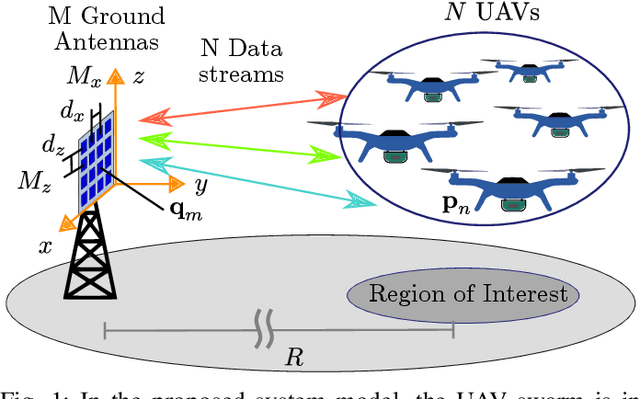
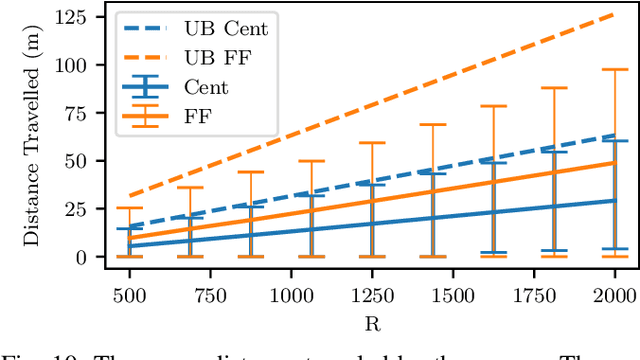
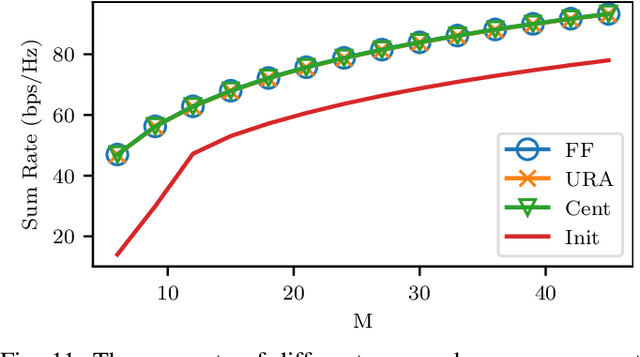
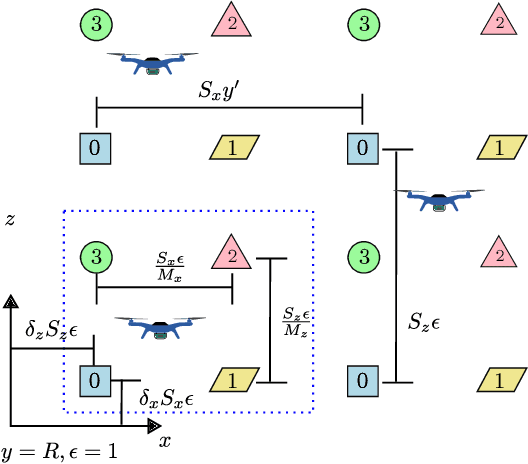
Abstract:A swarm of cooperating UAVs communicating with a distant multiantenna ground station can leverage MIMO spatial multiplexing to scale the capacity. Due to the line-of-sight propagation between the swarm and the ground station, the MIMO channel is highly correlated, leading to limited multiplexing gains. In this paper, we optimize the UAV positions to attain the maximum MIMO capacity given by the single user bound. An infinite set of UAV placements that attains the capacity bound is first derived. Given an initial swarm placement, we formulate the problem of minimizing the distance traveled by the UAVs to reach a placement within the capacity maximizing set of positions. An offline centralized solution to the problem using block coordinate descent is developed assuming known initial positions of UAVs. We also propose an online distributed algorithm, where the UAVs iteratively adjust their positions to maximize the capacity. Our proposed approaches are shown to significantly increase the capacity at the expense of a bounded translation from the initial UAV placements. This capacity increase persists when using a massive MIMO ground station. Using numerical simulations, we show the robustness of our approaches in a Rician channel under UAV motion disturbances.
 Add to Chrome
Add to Chrome Add to Firefox
Add to Firefox Add to Edge
Add to Edge